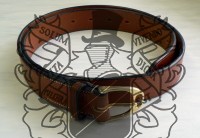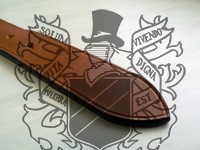Bridle Leather Characteristics
0April 24, 2013 by Ville Raivio
Bridle leather is tanned cowhide treated with a special finish, and named after its historical use in riding bridles. The hide’s both sides, flesh and grain, are treated with a multitude of natural greases and tallows, then finished off with natural waxes. These stages require time and patience, which make the material more expensive than regular chrome-tanned hides. Bridle leather surface must be smooth and flexible to feel comfortable on the horse’s skin, thus both grain and flesh are treated in similar way. The leather’s high grease and wax content prevent drying and cracking, and guarantee both strength and durability to all goods, even in heavy-duty use.
Products from Pukimo Raivio
Ralph Lauren, Black Label suit, size 52EU
With time and wear, waxes and oils may rise to the surface of bridle leather, forming what is termed a bloom or white patches. This is normal, and a sign of true bridle leather. The bloom can be buffed away with a soft cotton cloth, and afterwards the leather can be sniffed thoroughly for smart nasal pleasure.
Among the tanneries producing bridle leather today are the renowned British makers J&E Sedgwick&Co. Ltd. and J&FJ Baker&Co. Ltd. American bridle leather is made by Hermann Oak Leather and Wickett&Craig. Australia is home to Greenhalgh Tannery Pty. Ltd. Bridle leather has mostly been used for bridles, reins, saddles, belts and various bags, though this thick, oily material will serve equally well in most leather products. Stationaries, dog collars, picture frames, writing pads, pen cups and iPad cases are a small selection of bridle leather use. Most British bagmakers favour bridle leather for its strength and durability, which combine to make the leather peerless when the two attributes are sought.
Category Materials, Tanneries | Tags:





Leave a Reply